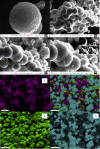Effect of Different TiO2 Morphologies on the Activity of Immobilized Lipase for Biodiesel Production
- PMID: 34984280
- PMCID: PMC8717535
- DOI: 10.1021/acsomega.1c04942
Effect of Different TiO2 Morphologies on the Activity of Immobilized Lipase for Biodiesel Production
Abstract
Lipase catalytic activity is greatly influenced by immobilization on nanoparticles. In this study, lipase from Aspergillus niger was immobilized on TiO2 nanoparticles with different morphologies: microspheres, nanotubes, and nanosheets. All TiO2 samples were prepared by a hydrothermal method. Lipase/TiO2 nanocomposites were prepared by a physical adsorption method through hydrophobic interactions. The prepared composites were characterized by Fourier transform infrared spectroscopy (FTIR), X-ray diffraction (XRD), scanning electron microscopy (SEM), and high-resolution transmission electron microscopy (HRTEM). The catalytic activity of free and immobilized lipases was tested using sunflower oil in the presence of methanol to produce biodiesel at 40 °C for 90 min. The lipase immobilized on TiO2 microspheres showed the highest activity compared to the lipase immobilized on TiO2 nanotubes and nanosheets. To optimize the lipase-to-microsphere ratio, lipase was immobilized on TiO2 microspheres in different microspheres/lipase, w/w, (S/L) ratios of 1:1, 1:0.75, 1:0.5, and 1:0.25. It was noticed that the hydrolytic activity follows the order 1:0.25 > 1:0.5 > 1:75 > 1:1. The immobilization yield activities were found to be 113, 123, 125, and 130% for the microspheres/lipase (S/L) ratios of 1:1, 1:0.75, 1:0.5, and 1:0.25, respectively.
© 2021 The Authors. Published by American Chemical Society.
Conflict of interest statement
The authors declare no competing financial interest.
Figures









References
-
- Brito M. J. P.; Bauer L. C.; Santos M. P. F.; Santos L. S.; Bonomo R. C. F.; Fontan R. D. C. I.; Veloso C. M. Lipase immobilization on activated and functionalized carbon for the aroma ester synthesis. Microporous Mesoporous Mater. 2020, 309, 11057610.1016/j.micromeso.2020.110576. - DOI
-
- Kumar R.; Pal P. Lipase immobilized graphene oxide biocatalyst assisted enzymatic transesterification of Pongamia pinnata (Karanja) oil and downstream enrichment of biodiesel by solar-driven direct contact membrane distillation followed by ultrafiltration. Fuel Process. Technol. 2021, 211, 10657710.1016/j.fuproc.2020.106577. - DOI
-
- Okura N. S.; Sabi G. J.; Crivellenti M. C.; Gomes R. A.; Fernandez-Lafuente R.; Mendes A. A. Improved immobilization of lipase from Thermomyces lanuginosus on a new chitosan-based heterofunctional support: Mixed ion exchange plus hydrophobic interactions. Int. J. Biol. Macromol. 2020, 163, 550–561. 10.1016/j.ijbiomac.2020.07.021. - DOI - PubMed
LinkOut - more resources
Full Text Sources

